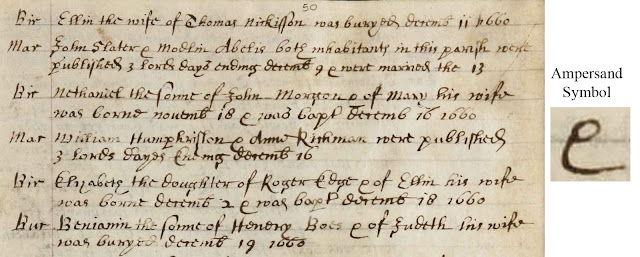No,
this is not about the King of Siam who used the phrase frequently when under
the tutelage of his English schoolmistress. It’s about the word, or most often
the abbreviation we have taken for granted forever in expressing an ongoing
list of things when we write or speak.
Many
people, outside of those who do a lot of transcribing of old English documents,
might not know it has been a part of the English language for centuries and was
often written with the ampersand symbol. Reading old documents one will
commonly come across both & and &c. Etcetera was originally a Latin
phrase, “et”. The ampersand itself means “and” which when written in front of “et”
or “c.” – as a ligature – would mean “and other things” and pronounced as
etcetera. Simple enough!
The
ampersand was at one time considered the 27th letter of the English
alphabet, placed at the end after ‘z’. It was described as “and per se &
(and)”.
From
the 1788 book titled, Court-Hand Restored
by Andrew Wright.
The
symbol has taken many forms over the years as well as being used in most
languages in Europe, having come from Latin roots. Its development is described
in a book by Jan Tschichold, Formenwandlungen der ET-Zeichen (The Ampersand: Its origin and development);
publisher: Woudhuysen, 1957.
One
of the diagrams showing the forms of the ampersand symbol over the years
(Tschichold, 1957)
In
old documents, it can be found written in several ways, separately or as part
of etcetera. BMD registers most often use the abbreviations.
1660
St. Clement Danes parish, Middlesex baptism register example
 |
1660
Whitchurch parish, Shropshire baptism register example
|
 | ||
1664
Acle Parish, Norfolk, marriage register example
|
This
is just one of many interesting symbols and letter styles found in old records.
North American documents from the 17th to the 19th
centuries are very similar to those of England and generally will have the same
writing style.
I’ll
look at other Old English writing example in later posts. In
the meantime, readers may wish to reacquaint themselves with a post from 5
August 2014 on Reading Old English.
Wayne Shepheard is a volunteer with the Online Parish Clerk program in England, handling four
parishes in Devon, England. He has published a
number of articles about various aspects of genealogy and is the Editor of Relatively
Speaking, the quarterly journal of the Alberta Genealogical Society.
Wayne also provides genealogical consulting services through his business, Family History Facilitated.



